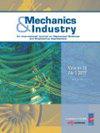Analysis of longitudinal vibration acceleration based on continuous time-varying model of high-speed elevator lifting system with random parameters
IF 1.2
4区 工程技术
Q3 ENGINEERING, MECHANICAL
引用次数: 4
Abstract
In this paper, for studying the influence of the randomness of structural parameters of high-speed elevator lifting system (HELS) caused by manufacturing error and installation error, a continuous time-varying model of HELS was constructed, considering the compensation rope mass and the tension of the tensioning system. The Galerkin weighted residual method is employed to transform the partial differential equation with infinite degrees of freedom (DOF) into the ordinary differential equation. The five-order polynomial is used to fit the actual operation state curve of elevator, and input as operation parameters. The precise integration method of time-varying model of HELS is proposed. The determination part and the random part response expression of the longitudinal dynamic response of HELS are derived by the random perturbation method. Using the precise integration method, the sensitivity of random parameters is determined by solving the random part response expression of time-varying model of HELS, and the digital characteristics of the acceleration response are analyzed. It is found that the line density of the hoisting wire rope has the maximum sensitivity on longitudinal vibration velocity response, displacement response and acceleration response, and the sensitivity of the elastic modulus of the wire rope is smallest.基于随机参数高速电梯提升系统连续时变模型的纵向振动加速度分析
为了研究制造误差和安装误差对高速电梯提升系统(HELS)结构参数随机性的影响,考虑补偿绳质量和张紧系统张力,建立了高速电梯提升系统的连续时变模型。采用伽辽金加权残差法将具有无限自由度的偏微分方程转化为常微分方程。采用五阶多项式拟合电梯实际运行状态曲线,并作为运行参数输入。提出了HELS时变模型的精确积分方法。采用随机摄动法推导了HELS纵向动力响应的确定部分和随机部分响应表达式。采用精确积分法,通过求解HELS时变模型的随机部分响应表达式,确定了随机参数的灵敏度,并分析了加速度响应的数字特性。研究发现,钢丝绳线密度对纵向振动速度响应、位移响应和加速度响应的敏感性最大,对钢丝绳弹性模量的敏感性最小。
本文章由计算机程序翻译,如有差异,请以英文原文为准。
求助全文
约1分钟内获得全文
求助全文
来源期刊

Mechanics & Industry
ENGINEERING, MECHANICAL-MECHANICS
CiteScore
2.80
自引率
0.00%
发文量
25
审稿时长
>12 weeks
期刊介绍:
An International Journal on Mechanical Sciences and Engineering Applications
With papers from industry, Research and Development departments and academic institutions, this journal acts as an interface between research and industry, coordinating and disseminating scientific and technical mechanical research in relation to industrial activities.
Targeted readers are technicians, engineers, executives, researchers, and teachers who are working in industrial companies as managers or in Research and Development departments, technical centres, laboratories, universities, technical and engineering schools. The journal is an AFM (Association Française de Mécanique) publication.
 求助内容:
求助内容: 应助结果提醒方式:
应助结果提醒方式:


